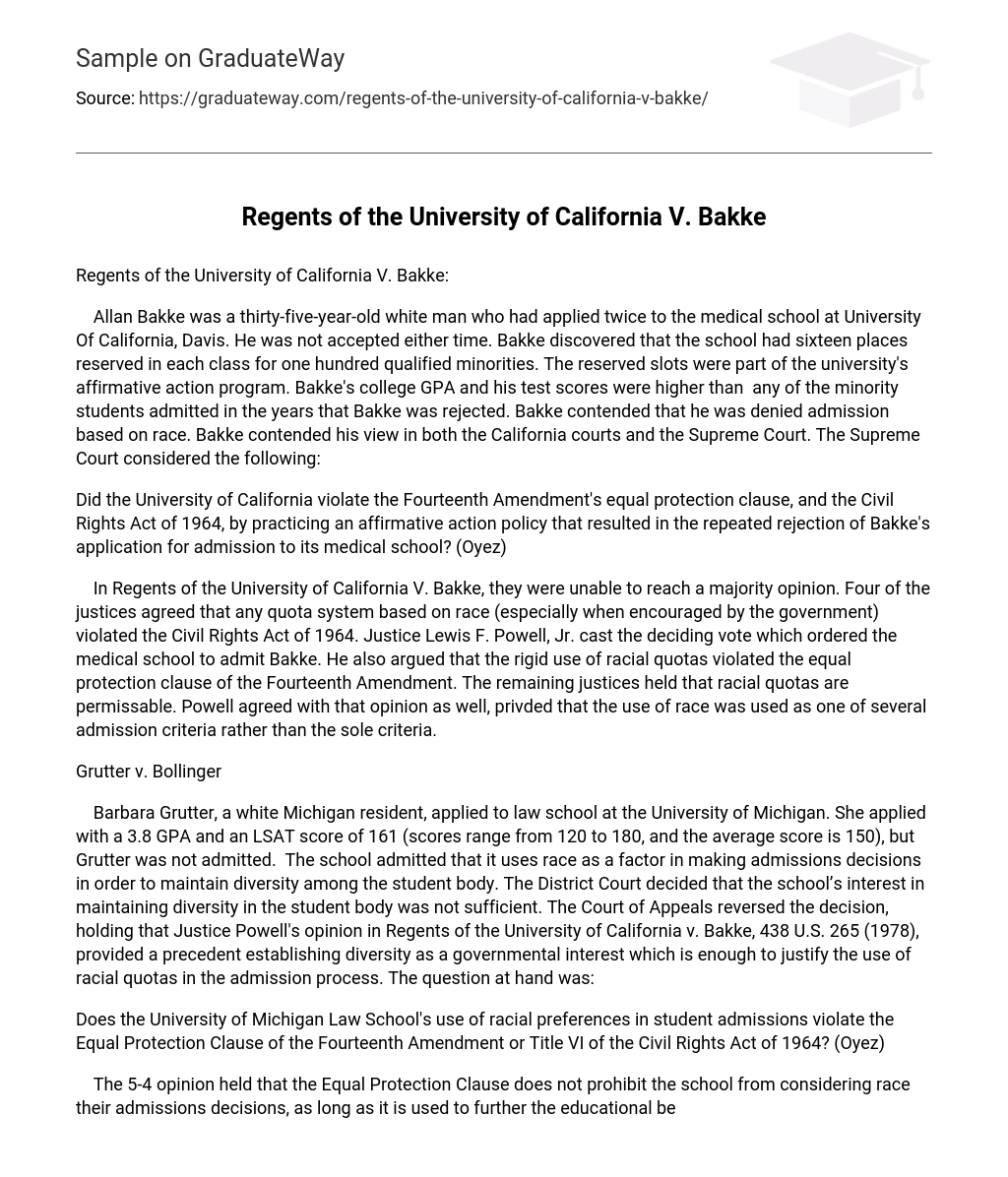Regents of the University of California V. Bakke:
Allan Bakke was a thirty-five-year-old white man who had applied twice to the medical school at University Of California, Davis. He was not accepted either time. Bakke discovered that the school had sixteen places reserved in each class for one hundred qualified minorities. The reserved slots were part of the university’s affirmative action program. Bakke’s college GPA and his test scores were higher than any of the minority students admitted in the years that Bakke was rejected. Bakke contended that he was denied admission based on race. Bakke contended his view in both the California courts and the Supreme Court. The Supreme Court considered the following:
Did the University of California violate the Fourteenth Amendment’s equal protection clause, and the Civil Rights Act of 1964, by practicing an affirmative action policy that resulted in the repeated rejection of Bakke’s application for admission to its medical school? (Oyez)
In Regents of the University of California V. Bakke, they were unable to reach a majority opinion. Four of the justices agreed that any quota system based on race (especially when encouraged by the government) violated the Civil Rights Act of 1964. Justice Lewis F. Powell, Jr. cast the deciding vote which ordered the medical school to admit Bakke. He also argued that the rigid use of racial quotas violated the equal protection clause of the Fourteenth Amendment. The remaining justices held that racial quotas are permissable. Powell agreed with that opinion as well, privded that the use of race was used as one of several admission criteria rather than the sole criteria.
Grutter v. Bollinger
Barbara Grutter, a white Michigan resident, applied to law school at the University of Michigan. She applied with a 3.8 GPA and an LSAT score of 161 (scores range from 120 to 180, and the average score is 150), but Grutter was not admitted. The school admitted that it uses race as a factor in making admissions decisions in order to maintain diversity among the student body. The District Court decided that the school’s interest in maintaining diversity in the student body was not sufficient. The Court of Appeals reversed the decision, holding that Justice Powell’s opinion in Regents of the University of California v. Bakke, 438 U.S. 265 (1978), provided a precedent establishing diversity as a governmental interest which is enough to justify the use of racial quotas in the admission process. The question at hand was:
Does the University of Michigan Law School’s use of racial preferences in student admissions violate the Equal Protection Clause of the Fourteenth Amendment or Title VI of the Civil Rights Act of 1964? (Oyez)
The 5-4 opinion held that the Equal Protection Clause does not prohibit the school from considering race their admissions decisions, as long as it is used to further the educational benefits that flow from a diverse student body. The Court further reasoned that, because the Law School reviews each application, that no acceptance or rejection is based solely on one variable (race included). Justice O’Connor wrote, “in the context of its individualized inquiry into the possible diversity contributions of all applicants, the Law School’s race-conscious admissions program does not unduly harm nonminority applicants.” (Oyez)
Hopwood V. The State of Texas
In 1992, Cheryl Hopwood, a white female, and Douglas W. Carvell, Kenneth R. Elliott, and David A. Rogers, three white males, contend that their Fourteenth Amendment rights were violated by the University of Texas Law School. This occurred when Hopwood, et. al. were denied admission in favor of less qualified black and Mexican American applicants, due to a racial quota system. Unlike previous cases, this case had a long road before it was over. In 1994, U.S. District Court ruled that a law school may consider race in admissions, either to maintain diverse enrollment or to fix previous discrimination. In March of 1996, The 5th U.S. Circuit Court of Appeals decided that to use race as a deciding factor in admissions is unconstitutional. In June of 1996, the U.S. Supreme Court declined to review the decision, resulting in the end of affirmative action in public universities in Texas. Nearly two years later, in March of 1998, Judge Sparks found that none of the plaintiffs would have been admitted in a racially-unbiased system. Judge Sparks entered an order prohibiting all future consideration of race in admissions. The Fifth Circuit agreed with Sparks in December of 2000, and the plaintiffs were eventually awarded attorney’s fees, but nothing else. Hopwood et. al. essentially won the case, because universities in Texas can no longer discriminate on the basis of race. However, the plaintiffs were not admitted as a result of the decision. In the end, justice was served because it became clear that the group would not have been admitted regardless of their race.
Works Cited:
“Grutter V. Bollinger.” The Supreme Court Multimedia. 2005. Oyez. 16 Nov 2006 <http://www.oyez.org/oyez/resource/case/1541/>.
“Hopwood V. State of Texas.” The Center for Individual Rights. 2005. The Center For Individual Rights. 16 Nov 2006 <http://www.cir-usa.org/cases/hopwood_v_texas.html>.
“Regents of the University of California v. Bakke.” The Supreme Court Multimedia. 2005. Oyez. 16 Nov 2006 <http://www.oyez.org/oyez/resource/case/324/abstract>.





